![]()
![]()
![]()
Use LEFT and RIGHT arrow keys to navigate between flashcards;
Use UP and DOWN arrow keys to flip the card;
H to show hint;
A reads text to speech;
27 Cards in this Set
- Front
- Back
|
Sheet Name
|
A map is named after the most prominent cultural or geographical feature. Whenever possible, the name of the largest city on the map is used.
The sheet name is found in two places: the center of the upper margin and either the right or left side of the lower margin. |
|
|
Sheet Number
|
The sheet number is used as a reference number for that map sheet. It is found in two places: the upper right margin and the lower left margin.
|
|
|
Scale
|
The scale note is a representative fraction that gives you the ratio of a distance on the map to the corresponding distance on the earth's surface. For example, the scale note 1:50,000 on many maps indicates that one inch on the map equals 50,000 inches on the ground.
The scale is found both in the upper left margin after the series name and in the center of the lower margin. |
|
|
Elevation Guide
|
The elevation guide is a miniature characterization of the terrain shown. The terrain is shown by bands of elevation, spot elevations, and major drainage features. The elevation guide helps you rapidly identify major land forms. It is normally found in the lower right margin
|
|
|
Declination Diagram
|
This indicates the angular relationships of true north, grid north, and magnetic north. Recent edition maps have a note indicating how to convert azimuths from grid to magnetic and from magnetic to grid next to the declination diagram. The declination diagram is located in the lower margin.
|
|
|
Bar Scales
|
Bar scales are used to convert map distance to ground distance. Maps may have three or more bar scales, each in a different unit of measure. Exercise care when using the scales, especially in the selection of the unit of measure. The bar scales are located in the center of the lower margin.
|
|
|
Legend
|
The legend illustrates and identifies the topographic symbols used to depict some of the more prominent features on the map, such as railroad tracks, buildings, and swamps. The symbols are not always the same on every map. Always refer to the legend to avoid error when reading a map. The legend is located in the lower left margin
|
|
|
Grid Lines
|
Grid lines are a series of straight lines intersected at right angles and forming a series of squares. It furnishes the map reader with a system of squares similar to the block system of most city streets. Two digits are printed in large type at each end of the grid lines, and these same two digits appear at intervals along the grid lines on the face of the map. They are called principal digits. They are of major importance to the map reader because they are the numbers he will use most often for referencing points.
|
|
|
Grid Squares
|
These intersect at right angles of the horizontal and vertical grid lines. The most common military map contains grid squares that measure 1000 meters by 1000 meters (not 1000 square meters as many people think). Any point located within the grid square is considered to be part of the grid square.
|
|
|
Basic Map Reading Rule
|
The designation of a point is based on the principle: Read right then up. Always read right on the vertical grid lines then up on the horizontal grid lines.
|
|
|
How accurate is a four digit grid?
Ex: 12A BC 12 34 |
locates a point to within 1000 square meters, on the map, which is called a grid square.
|
|
|
How accurate is a six digit grid?
Ex: 12A BC 123 456 |
100m
|
|
|
How accurate is a eight digit grid?
Ex: 12A BC 1234 5678 |
10m
|
|
|
How accurate is a eight digit grid?
Ex: 12A BC 12345 67890 |
1m
|
|
|
True North
|
The true north line is a line from any point on the earth's surface to the North Pole. True north can be found at night by locating the North Star, which always points towards true north. True north is usually represented on the declination diagram by a line ending with a star. True north is used almost exclusively when navigating without a compass.
|
|
|
Magnetic North
|
The earth has a magnetic field that is close to (but not exactly on) the North Pole. The direction to this north magnetic pole is indicated by the north-seeking arrow of your lensatic compass. Magnetic north is usually symbolized on the declination diagram by a line ending with a half arrowhead. Anytime you use the compass to plan or follow an azimuth in the field, you must work with azimuths measured from magnetic north
|
|
|
Grid North
|
This base line is established by using the vertical grid lines on the map. Grid north may be symbolized on the declination diagram by the letters GN. Anytime you use a protractor in conjunction with a vertical grid line to determine or plot an azimuth on a map, you must work with an azimuth measured from grid north
|
|
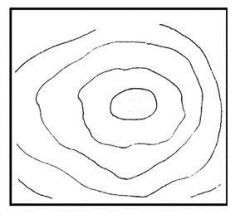
|
Hill - A hill is an area of high ground. From a hilltop, the ground slopes down in all directions. A hill is shown on a map by contour lines forming concentric circles. The inside of the smallest closed circle is the hilltop.
|
|
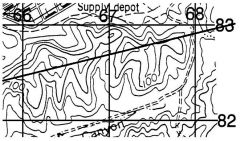
|
Ridge - A ridge is a series of hills that are connected to each other near the top. A ridge line may extend for many miles. It may be winding or quite straight. It may have a reasonably uniform elevation along its top or it may vary greatly in elevation
|
|
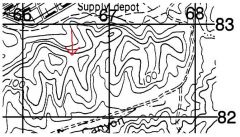
|
Saddle - This is a dip or low point between two areas of higher ground. A saddle is not necessarily the lower ground between two hilltops; it may be simply a dip or break along a level ridge crest. If you are in a saddle, there is high ground in two opposite directions and low ground in the other two directions. A saddle is normally represented as an hourglass or by figure-eight shaped contour lines.
|
|
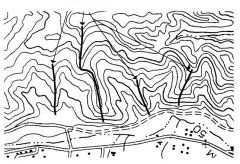
|
Finger/Spur - A finger is a short, continuous sloping line of higher ground, normally jutting out from the side of a ridge or hill. A finger is often formed by two roughly parallel draws. The ground slopes down in three directions and up in one. Contour lines on a map depict a finger with the U or V pointing away from high ground.
|
|
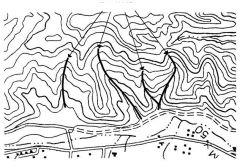
|
Draw - . A draw is a short, continuous sloping line of low ground, normally cut into the side of a ridge or hill. Often, there is a small stream running down the draw. In a draw, there is essentially no level ground. Therefore, little or no maneuver room exists within its confines. If you are standing in the middle of a draw, the ground slopes upward in three directions and downward in the other direction. Contour lines (see figure 1201-12) on a map depict a draw with the U or V pointing toward high ground.
|
|
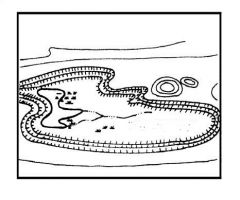
|
Depression - This is a low point in the ground or a sinkhole. It is an area of low ground surrounded by higher ground in all directions, or simply a hole in the ground. Usually only depressions that are equal to or greater than the contour interval will be shown. On maps, depressions are represented by closed contour lines that have tick marks pointing toward low ground
|
|
|
What are the two ways to orientate a map?
|
With a Compass
Terrain Association |
|
|
How do you orientate a map with a compass?
|
-Set declination on the compass
-Set compass to north -Lye map flat and line up compass with gridlines. -Put red in red |
|
|
How do you use Terrain Association?
|
-Identify prominent terrain features on the map that you can find on the ground.
-Align terrain features with the map |
|
|
Location by inspection
|
You are standing in the vicinity of several prominent features which can easily be located on the map. By orienting the map and estimating your relation to these features, you should have no difficulty in determining your location.
|

